Saddam's Palaces: An Interview with Richard Mosse
 [Image: Ruined swimming pool at Uday's Palace, Jebel Makhoul, Iraq (2009); photo by Richard Mosse].
[Image: Ruined swimming pool at Uday's Palace, Jebel Makhoul, Iraq (2009); photo by Richard Mosse].Photographer Richard Mosse first appeared on BLDGBLOG last year with his unforgettable visual tour through the air disaster simulations of the international transportation industry.
He and I have since kept in touch —so, when Mosse returned from a trip to Iraq this spring, he emailed again with an unexpectedly intense, and hugely impressive, new body of work.
These extraordinary images—published here for the first time—show the imperial palaces of Saddam Hussein converted into temporary housing for the U.S military. Vast, self-indulgent halls of columned marble and extravagant chandeliers, surrounded by pools, walls, moats, and, beyond that, empty desert, suddenly look more like college dormitories. Weight sets, flags, partition walls, sofas, basketball hoops, and even posters of bikini'd women have been imported to fill Saddam's spatial residuum. The effect is oddly decorative, as if someone has simply moved in for a long weekend, unpacking an assortment of mundane possessions.
The effect is like an ironic form of camouflage, making the perilously foreign seem all the more familiar and habitable—a kind of military twist on postmodern interior design.
Of course, then you notice, in the corner of the image, a stray pair of combat boots or an abandoned barbecue or a machine gun leaned up against a marble wall partially shattered by recent bomb damage—amidst the dust of collapsed ceilings and ruined tiles—and this architecture, and the people who now go to sleep there every night, suddenly takes on a whole new, tragic narrative.
Fascinated by the dozens and dozens of incredible photos Mosse emailed—only a fraction of which appear here—I asked him to describe the experience of being a photographer in Iraq.
The ensuing dialogue appears below.
• • •
BLDGBLOG: What was the basic story behind your visit to Iraq? Was it self-funded or sponsored by a gallery?
Richard Mosse: The trip was backed by a Leonore Annenberg Fellowship in the Performing and Visual Arts, which I received after graduating from Yale last summer with an MFA in photography. The Fellowship provides enough to fund two full years of traveling to make new photographs, and I applied to shoot in a range of places, including Iraq. My proposal was to make work around the idea of the accidental monument. I'm interested in the idea that history is something in a constant state of being written and rewritten—and the way that we write history is often plain to see in how we affect the world around us, in the inscriptions we make on our landscape, and in what stays and what goes.
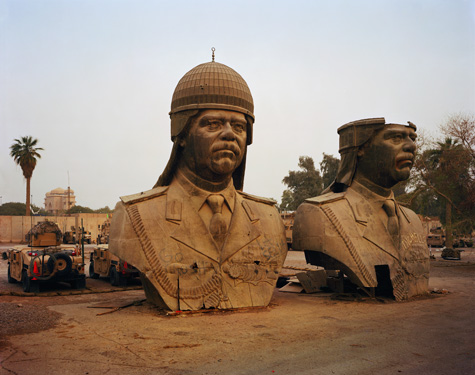 [Image: Saddam's heads, taken from the roof of the Republican Guard Palace, now located at Al-Salam Palace, Forward Operating Base Prosperity, Baghdad, Iraq (2009); photo by Richard Mosse].
[Image: Saddam's heads, taken from the roof of the Republican Guard Palace, now located at Al-Salam Palace, Forward Operating Base Prosperity, Baghdad, Iraq (2009); photo by Richard Mosse].I suppose it's an idea that captured me while traveling through Kosovo in 2004. I saw a building by the side of the road there that lay mined and shattered in a field of flowers. It was almost entirely collapsed—except for a church cupola which lay at a pendulous angle, though otherwise perfectly intact on a pile of rubble. It was a marvelously pictorial vision of the Kosovo Albanian desire to rewrite the history books. In other words, what I saw before me was not an act of mere vandalism, but a decisive act by the Kosovo Albanian community to disavow the fact of Serb Orthodox church heritage in the region. The removal of religious architecture is a terrible crime, and it constitutes an act of ethnic cleansing (remember Kristallnacht); yet I couldn't help but interpret this as an attempt to create a brave new Kosovo Albanian world.
I began to see architecture as something that can reveal the ways in which we alter the past in order to construct a new future, as a site in which past, present, and future come together to be reformed. And it's not the only one: language—our words and the way we use them—are another fine barometer of these things.
But architecture is something I felt I could research and portray using the dumb eye of my camera.
 [Image: JDAM bomb damage within Saddam's Palace interior, Jebel Makhoul, Iraq (2009); photo by Richard Mosse].
[Image: JDAM bomb damage within Saddam's Palace interior, Jebel Makhoul, Iraq (2009); photo by Richard Mosse].BLDGBLOG: Beyond the most obvious reasons—for instance, there's a war going on—why did you go to Iraq? Was there something in particular that you were hoping to see?
Mosse: I had heard plenty about Saddam's palaces. They were the focus of the International Atomic Energy Association's tedious investigations in the years preceding the invasion, and the news was always full of delegations being turned away from this or that palace. Why were we so keen to get inside Saddam's palaces? Because he built so many—81 in total. Surely, we thought, he must be hiding something in those palace complexes. Surely he must be building subterranean particle accelerators. And, in the end, our curiosity got the better of us.
 [Image: U.S.-built partition and air-conditioning units within Al-Salam Palace, Forward Operating Base Prosperity, Baghdad, Iraq (2009); photo by Richard Mosse].
[Image: U.S.-built partition and air-conditioning units within Al-Salam Palace, Forward Operating Base Prosperity, Baghdad, Iraq (2009); photo by Richard Mosse].In fact, Saddam was building palaces in every city as an expression of his authority. Palace architecture in Iraq served as a constant reminder of Saddam's immanence. A palace in your city simply fed the sense that Saddam was not just nearby—he was everywhere. Saddam was omnipresent.
I once heard a Westerner tell me that, prior to the invasion, Iraqis driving near one of Saddam's palaces would actually avert their eyes—they would refuse to look toward the palace. It was almost as if they were prisoners in a great outdoor version of Jeremy Bentham's Panopticon. Curiously, the sentry towers along the perimeter walls of Al-Salam Palace in Baghdad face only outward; they're screened from looking inward at the palace itself. People say it's so the guards could not witness Saddam's eldest son Uday's relations with underage girls, but I rather like to think that it created a sense of the unseen authoritarian staring blankly outwards. It was like those ominous black turrets that the British army constructed over the hills of Belfast, packed with listening devices and telescopic cameras.
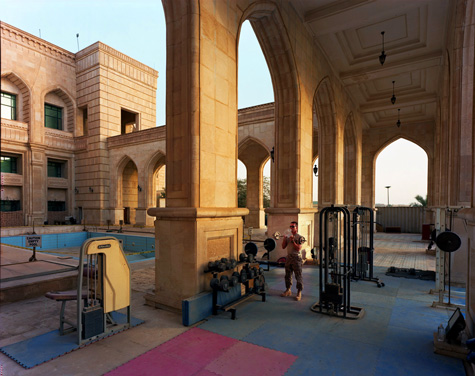 [Image: Outdoor gym, Al-Faw Palace, Camp Victory, Baghdad, Iraq (2009); photo by Richard Mosse].
[Image: Outdoor gym, Al-Faw Palace, Camp Victory, Baghdad, Iraq (2009); photo by Richard Mosse].But the idea of Iraqis averting their eyes from Saddam's palace architecture also reminds me of something from W.G. Sebald's book On the Natural History of Destruction.
BLDGBLOG: That's an incredible book – I still can't forget his descriptions of tornadoes of fire whirling through bombed cities and melting asphalt.
Mosse: Sebald recounts how the German population, after the end of WWII, would ride the trains, staring into their laps or at the ceiling—anywhere but out the window at the terrible wreckage of their cities. It was as if they were somehow disavowing the war by willing it away, by refusing to perceive it.
It's interesting, then, that, in both instances—in both Iraq and in post-war Germany—it's the tourist, or the outsider, who observes this blindness. I suppose that's why I like to make photographs in foreign places: only the tourist notices the really dumb things that everyone else takes for granted.
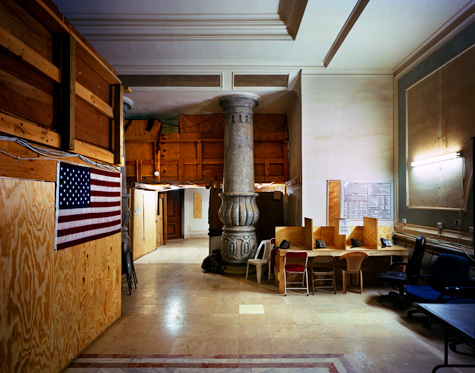 [Image: U.S. military telephone kiosks built within Birthday Palace interior, Tikrit, Iraq (2009); photo by Richard Mosse].
[Image: U.S. military telephone kiosks built within Birthday Palace interior, Tikrit, Iraq (2009); photo by Richard Mosse].BLDGBLOG: The way these structures have been colonized is often amusing and sometimes shocking—the telephones, desks, and instant dormitories that turn an imperial palace into what looks like a suburban office or hospital waiting room. Can you describe some of the spatial details of these soldiers' lives that most struck you?
Mosse: It was extraordinary how some of the palace interiors had been transformed to accommodate the soldiers. Troops scurried beneath vaulted ceilings and glittering faux-crystal chandeliers. Lofty marble columns towered over rat runs between hastily constructed chipboard cubicles. Obama's face beamed out of televisions overlooking the freezers and microwaves of provisional canteen spaces.
Many of the palaces have already been handed back to the Iraqis—but where Americans troops do remain, they live in very cramped conditions, pissing into a hole in the ground and waiting days just to shower. Life is hard on the front line, and it seems more than a little surreal to be ticking off the days in a dictator's pleasure dome.

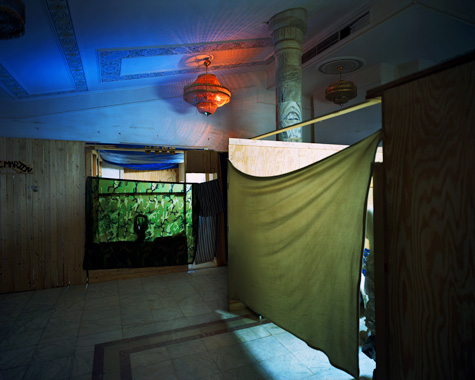 [Images: American dormitories built within Saddam's Birthday Palace, Tikrit, Iraq (2009); photos by Richard Mosse].
[Images: American dormitories built within Saddam's Birthday Palace, Tikrit, Iraq (2009); photos by Richard Mosse]. The most interesting thing about the whole endeavor for me was the very fact that the U.S. had chosen to occupy Saddam's palaces in the first place. If you're trying to convince a population that you have liberated them from a terrible dictator, why would you then sit in his throne? A savvier place to station the garrison would have been a place free from associations with Saddam, and the terror and injustices that the occupying forces were convinced they'd done away with. Instead, they made the mistake of repeating history.
This is why I've titled this body of work Breach. "Breach" is a military maneuver in which the walls of a fortification (or palace) are broken through. But breach also carries the sense of replacement—as in, stepping into the breach. The U.S. stepped into the breach that it had created, replacing the very thing that it sought to destroy.
There are other kinds of breach—such as a breach of faith, a breach of confidence, or the breach of a whale rising above water for air. All of these senses were important to me while working on these photographs.
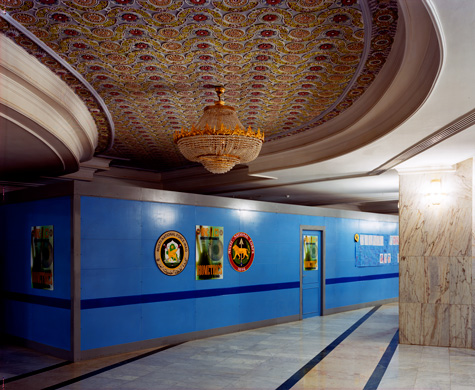 [Image: Provisional office wall partitions within Al-Faw Palace, Camp Victory, Baghdad, Iraq (2009); photo by Richard Mosse].
[Image: Provisional office wall partitions within Al-Faw Palace, Camp Victory, Baghdad, Iraq (2009); photo by Richard Mosse]. BLDGBLOG: In several of these photos, the soldiers are literally lifting tiles up from the floor as if the buildings had been left unfinished, or they're peering through cracks in the palace walls. From what you could see, were Saddam's palaces badly constructed or were they just heavily damaged during the war?
Mosse: Tiles simply fell from Al-Faw Palace because the cement used there had been poorly salinated. If that can happen to tiles, think what's happening when the entire palace has been built on similarly salinated foundations! It's just a matter of time before Al-Faw collapses in on itself.
You can already see arches cracking and walls beginning to sag.
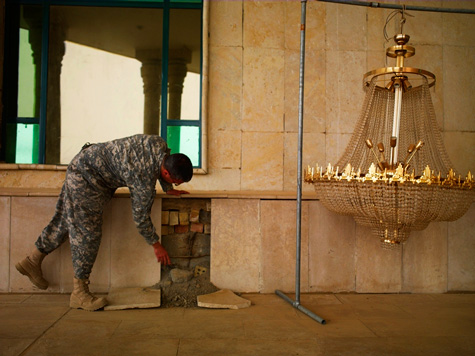 [Image: Fallen tiles and chandeliers, Al Faw Palace, Camp Victory, Baghdad, Iraq (2009); photo by Richard Mosse].
[Image: Fallen tiles and chandeliers, Al Faw Palace, Camp Victory, Baghdad, Iraq (2009); photo by Richard Mosse]. But I'm reluctant to include images of U.S. soldiers pointing out problems with Saddam's architecture, because it's fairly evident that those could be a form of propaganda—and it's easy to forget that many of these palaces were built during times of terrible sanctions imposed by the West. It might not seem very clear why Saddam was busy building palaces in a time of sanctions, but remember how the WPA was set-up during the Great Depression? I don't want to risk being called an apologist for Saddam, but there are many ways to read a story.
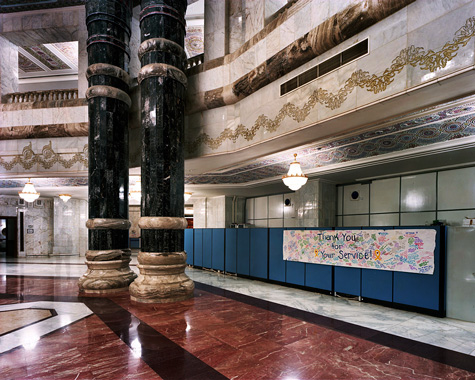 [Image: "Thank you for your service" banner, Al-Faw Palace interior, Camp Victory, Iraq (2009); photo by Richard Mosse].
[Image: "Thank you for your service" banner, Al-Faw Palace interior, Camp Victory, Iraq (2009); photo by Richard Mosse]. That said, the palace is a fabulous monument to rushed construction, poor materials, and gaudy pomp. Saddam had apparently insisted that the palace be finished within two years, so many shortcuts were taken during construction. For example, the stairway banisters were made of crystallized gypsum—rather than carved marble—and where pieces didn't quite fit together, they were just sanded down rather than replaced. Marble that was used in the palace (such as in the great spacious bathrooms) was imported from Italy, in spite of the trade embargo. And the plaster cast frescoes in the ceilings were imported from Morocco.
 [Image: Stairway, Al-Faw Palace, Camp Victory, Baghdad, Iraq (2009); photo by Richard Mosse].
[Image: Stairway, Al-Faw Palace, Camp Victory, Baghdad, Iraq (2009); photo by Richard Mosse]. Al-Faw Palace later became the U.S, Army's Command HQ, located at the heart of Camp Victory, near Baghdad International Airport. The palace is now teeming with generals, including General Odierno, the commander of coalition forces in Iraq. It's a great, tiered wedding-cake structure, built around an inner hall with possibly the biggest and ugliest chandelier ever made. In fact, the chandelier is not made of crystal, but from a lattice of glass and plastic.
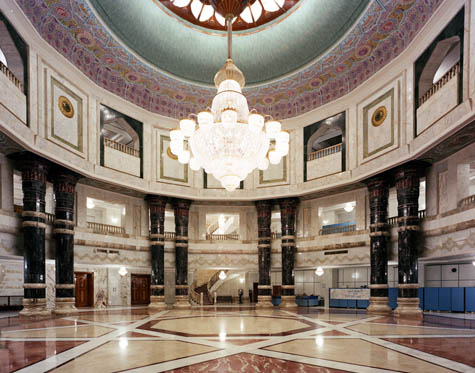 [Image: Chandelier, Al-Faw Palace, Camp Victory, Baghdad, Iraq (2009); photo by Richard Mosse].
[Image: Chandelier, Al-Faw Palace, Camp Victory, Baghdad, Iraq (2009); photo by Richard Mosse].The palace itself is then surrounded by a lake, which seems a bit like a moat—and it would be tempting to take a swim there, but the moat has been turned into a standing pool for Camp Victory's sewage. In the summer, the place must be rather unpleasant: rank in all senses of the word, both military and sanitary. These artificial lakes surrounding the palace are also populated by the infamous "Saddam Bass." It's said that Saddam would feed the bodies of his political opponents to these monsters. In fact, they're not bass at all, but a breed of asp fish. U.S. troops stationed at Camp Victory love to fish on these lakes, and a 105-pound specimen was recently caught.
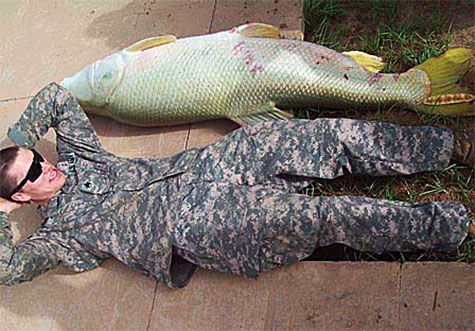 [Image: Tigris Salmon caught at Camp Victory Base, measuring 5 feet 10.5 inches and weighing 105 lbs. Image courtesy of the U.S. Army].
[Image: Tigris Salmon caught at Camp Victory Base, measuring 5 feet 10.5 inches and weighing 105 lbs. Image courtesy of the U.S. Army].BLDGBLOG: How was your own presence received by those soldiers? Did you present yourself as a photojournalist or as an art photographer?
Mosse: The difference between art and journalism is, for me, of paramount importance—but twenty minutes in Iraq, and the dialectic recedes. I got a vague sense that Americans working there feel a little forgotten—unappreciated by people at home—so they're very grateful for a camera, any camera, coming through. Even a big 8"x10" bellows camera with an Irishman in a cape. There were a lot of rather obvious photographs that I chose not to make, and occasionally someone got offended by this.
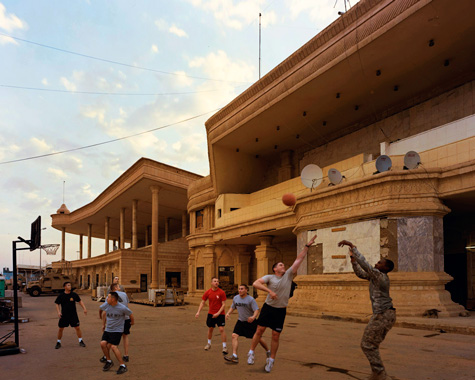 [Image: A game of basketball, Birthday Palace, Tikrit, Iraq (2009); photo by Richard Mosse].
[Image: A game of basketball, Birthday Palace, Tikrit, Iraq (2009); photo by Richard Mosse]. BLDGBLOG: What was the soldiers' opinion of these buildings? Did they ever just wander around and explore them, for instance, or was that a safety violation?
Mosse: I got the feeling that soldiers who occupied one of Saddam's palaces were pretty interested in its original function. They seemed a lot more together, and happier with their job, compared with the troops I met on the massive, sprawling, purpose-built military bases in the Iraqi desert. Constant reminders of hierarchy and protocol were everywhere on the bigger bases—but on the more cramped and less comfortable palace bases, soldiers of different ranks seemed much closer and more capable of shooting the shit with each other, to borrow an American turn of phrase.
Though a far tougher environment, there seemed to be real job satisfaction—a sense that they were taking part in a piece of history.
 [Image: Detail of U.S. soldier's living quarters, Birthday Palace interior, Tikrit, Iraq (2009); photo by Richard Mosse].
[Image: Detail of U.S. soldier's living quarters, Birthday Palace interior, Tikrit, Iraq (2009); photo by Richard Mosse]. BLDGBLOG: Architect Jeffrey Inaba once joked, in an interview with BLDGBLOG, that Saddam's palaces look a bit like McMansions in the suburbs of New Jersey. He quipped that "the architecture of state power and the architecture of first world residences don’t seem that far apart. Saddam’s palaces, while they’re really supposed to be about state power, look not so different from houses in New Jersey." They're not intimidating, in other words; they're just tacky. They're kitsch. Now that you've actually been inside these palaces, though, what do you think of that comparison?
Mosse: Well, I've never been inside a New Jersey McMansion, so I can't pass judgment. However, "McMansion" is a term borrowed by us in Ireland, where I'm from. Ireland was hard-hit by English penal laws, from the 17th century onward. One of those laws was the Window Tax. This cruel levy was imposed as a kind of luxury tax, to take money from anyone who had it; the result was that Irish vernacular architecture became windowless. The Irish made good mileage on the half-door, for instance, a kind of door that can be closed halfway down to keep the cattle out but still let the light in.
Aside from this innovation, and from subtleties in the method of thatching, Irish architecture never fully recovered—to the point that, even today, almost everyone in my country chooses their house from a book called Plan-a-Home, which you can buy for 15 euros. And if you have extra cash to throw in, you can flick to the back of the book and choose one of the more spectacular McMansions. Those are truly Saddam-esque.
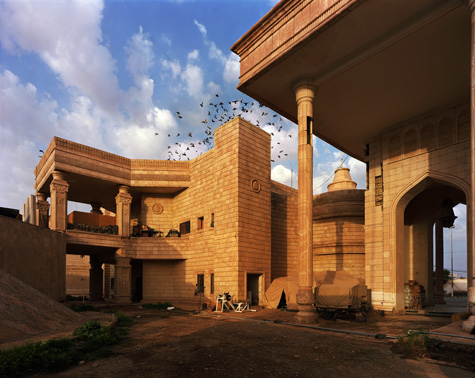 [Image: Birthday Palace, Tikrit, Iraq (2009); photo by Richard Mosse].
[Image: Birthday Palace, Tikrit, Iraq (2009); photo by Richard Mosse]. BLDGBLOG: Finally, the "Green Zone," as well as many of these palaces, are notoriously insular, cut-off behind security walls from the rest of Iraq. Did you actually feel like you were in Iraq at all—or in some strange architectural world, of walls and dormitories, surrounded by homesick Americans?
Mosse: Not all of Saddam's palaces are as isolated from reality as those situated in the green zone (or international zone, as it's now called). One I visited near Tikrit—Saddam's Birthday Palace—was even right at the heart of the city. Saddam was said to visit the palace each year on his birthday.
Wherever you go on the base, you're eminently shootable—a fantastic sniper target—and can hear the coming and going of Iraqis in the surrounding neighborhoods. It's a remarkable experience to go up to the roof with the pigeons at dusk and watch the changing light. You get a palpable impression of the great tragedy of the Iraq war, and you can see for yourself the fencing between neighborhoods, the rubbish strewn everywhere, the emptiness of the place, and you can hear the packs of dogs baying about. But you can also hear occasional shots fired in the distance, and you get the distinct feeling that you're being watched.
I spent a very slow month in Iraq trying to reach as many of these palaces as possible. I only managed to visit six out of eighty-one palaces. It is impossibly slow going over there, working within the war machine. These palaces are currently being handed back to the Iraqis, and many of them will be repurposed, sold to private developers or demolished. If I could get the interest of a publisher, for instance, I would return to Iraq to complete the project before Saddam’s heritage, and the traces of U.S. occupation, are entirely removed.
• • •
Thanks again to Richard Mosse for the incredible opportunity to talk to him about this trip, and for allowing BLDGBLOG to publish these images for the first time.
Be sure to see the rest of Mosse's work on his website. Hopefully the entirety of Breach will be coming soon to a book or gallery near you.





Comments are moderated.
If it's not spam, it will appear here shortly!
Unbelievable! Gorgeous images too. Only on BLDGBLOG.
An awesome first hand experience of these palaces is always fascinating and paints us a clearer picture of Saddam's puppet like dominance over the people of Iraq. His half built - half makeshift palaces to instill fear and power over the citizens.
I can't wait to hear when these monuments to the tyrant are torn down or turned into a museum for later generations of Iraqis to learn a painful but important lesson of what had happened to their parents and grandparents time.
When will we see pictures of the new US embassy in Iraq?
"but where Americans troops do remain, they live in very cramped conditions, pissing into a hole in the ground and waiting days just to shower. Life is hard on the front line"
That describes how the vast majority of people live right now.
This is kind of how I imagine Rome must have looked after the fall of the Empire. The Emperors were a lot like Saddam in so many ways...
Saddam’s palaces, while they’re really supposed to be about state power, look not so different from houses in New Jersey.I think a more accurate way to read this quote would be to reverse it. The underlying implication is not that the palaces should be dismissed as simply tacky, but that 'McMansions' are actually just the latest iteration in the tradition of the North American single-family home... a tradition which has always been all about channeling and evoking echoes of state power!
That understanding makes it even more ironic that these 'palaces', with their shoddy construction, giant useless atria, and priority of impressiveness over purpose or comfortableness, have come full circle to meet the McMansions in their quality as well as in their desired meanings.
great photos and interview, and good post! thank you.
@GlenH
Man, you have to study better... the purpose of Roman Empire was totally different in many ways..even if was a conquer war.. the romans have teach and bring a lot of countries many goods...also they tended to be really tolerant towards most religions.. and the legacy in terms of architecture, astrology, arts is immense!
...and for a lighter connection between architecture and autocrats.
http://famousarchitect.blogspot.com/2008/07/56-listen-to-little-devil-on-your.html
What an interesting interview and some really impressive images. I wholeheartedly hope Mosse gets a publisher's backing so he can document the inside of all of Saddam's palaces, as a reference not only for the Iraqi people but the world. It would be a shame if they were reduced to mere mythical mausoleums. I imagine they are already in a certain state of disarray after being looted and squatted in by troops!
These pictures remind me of how thankful I am for our military. Even though they are living in these old palaces it doesnt look comfortable at all. Imagine what its like waking up in one of those buildings and the daily reminder of the evil that went on there. I couldnt stand the enviroment.
I do have to agree with the previous post. These would have made for great tourism.
I think they do not know how to take care of a beautiful place and do not deserve to be there. Barbarians all.
-Dan
I think the mentality among many responsible for the negligence of the palace is that any culture that stands in the way of American domination and "democratization" is not worth keeping, however ancient, sophisticated, and deep-rooted it may be, and should be destroyed and replaced by ones that fit with American values in its place.
Which would make America's general disrespect for the rest of the (much more ancient) world quite unsurprising.
Please dont put all Americans in the same category. Just like Im sure all the people in your culture are not the wisest either.
There are some Americans over here that would give anything to be able to go and view the ancient world and take in all of its beauty and history. There are so many beautiful deep rooted buildings like you said over there that are not here and that is what makes I think makes all the continents across the waters so special. You have a long line of history.
If an American were to abuse any historical building in the presence of people like me, there would definitely be an argument. There are penalties over here for that so they should not be carrying on the behavior over there.
I am so sorry that you feel this way about all of us. We are truly not all the same. Look at the racism issues over here.
I do think the army should get out of these places, it seems fairly insulting to the Iraqi people. I d realise they have handed most of them back, there's 86 of them throughout the country! but I'm hoping they will move out once the gigantic US embassy is built.
However, to me the camp names are really stupid, and could only server to inflame Iraqi opinion against the US soliders. Camp Prosperity? Camp Vitory? Is the US Army run by five-year-olds? How much prosperity & victory have the Iraqis had lately?
But of course they hate you for your freedom, not your pompous arrogant posturing!
I must agree the soldiers should not be living in the palace, it's not just insulting but it's also an affront because the palace itself is like a museum of Iraqi art and culture, which numerous sculptures and paintings that have been destroyed or are at risk of being destroyed.
Having been in a few of these palaces, Al Faw was not alone in being hastily built and gaudy or trashy. The sense in the architecture isn't one of awe, history, or beauty, but a desperate desire for acceptance as a cultured autocrat. Saddam's name is worked into the (rather cheap) plaster and faux-gold appliqués everywhere to remind his people, his guards, and his family that they were subjects.
The reason why the coalition forces tended to occupy the palaces were that they were readily available, unused, and mostly secure on large parcels of defensible land.
Before we drone on about the historical and architectural worth of the palaces, we should probably ask the Iraqis what they think about them. Those I spoke with saw them as emblems of oppression and would be glad to see them destroyed and replaced by something truly celebratory of their shared culture and history. Leave a few standing, as a cultural warning, but otherwise they have no inherent cultural value.
I can not imagine the palace as a tourist place, maintained, preserving the hedonism and luxury of this emperor.
Why No? Keep the ruins of that? ruins? Crystallize the place in your home? false and inveridico as las vegas
GREAT WORK!!!!!!!GREAT PHOTOS!!!!
eduardo marins - brazil
Wow, never seen the images of Saddam's palaces. Thanks for these wonderful snaps.
Beautiful photographs. Thank you for this interview!
@neil:
you'd really liked the name of the farps, chevron, shell and texaco just to name a few.
don't forget camp pennsylvania, camp thunder, camp anaconda, camp victory.
Unbelievable. Not only because of the amazing subject matter but the images themselves are stunning too. Particularly love the one with the outdoor gym. Thanks for the interview!
You can not be greatest power by using military might on others but by understanding culture and the values of other civilizations and keeping them safe and secure so that other can value it and see it.
I hope current US President will correct this what other Presidents did not.
Beautiful photography. My opinion is that the palaces look kind of like Las Vegas and perhaps has some kind of haunting charm all their own...in a scary, post apocolyptic kind of way.
ALL OF IT SHOULD BELONG TO THE UNITED STATES OF AMERICA...JUST LIKE JAPEN SHOULD HAVE BEEN AFTER THE SECOND WORLD WAR....
regarding the detail of the soldiers quarters, it seems strange that the flag is hung incorrectly......otherwise, very good pictures
Check out the schweet Hookah in that "soldier's living quarters, Birthday Palace interior, Tikrit, Iraq" (2nd from last pic). Wonder how tha weed is over there? Ya can barely smoke a cig in the US anymore. Good to see troops partaking in herbal delights. I'm sure the Bush-Cheeny wingnuts will blame this on Obama too.. LOL
Wow, that's how America trash other people country in the name of terrorism? or corporate America (Exon, BP, ext..)??
15 of the 19 hijackers were Saudi Arabia, I am sure they have better palaces, why we didn't invade them?. This is sick to see this country (USA) as so call super power invade another country for their resources. I am ashamed to be an American, for Christ sake we sent people to the moon back in the 60's almost 40 years ago. If I understand correctly, we cannot develop alternate fuel so we have to invade Iraq to feed our gas guzzler automobile??
Wow, I guest God bless the USA.
PHOTO SHOP! A few of these photo's look to me as if they have been photoshopped. The decals on the wall in the blue corridor. And the dorm office in the last picture. Most of them are regular photographs, which is why I can tell the difference.
These pictures are first and foremost monuments over the unparalelled US ignorance and political stupidity. Does anyone remember why US entered Iraq in the first place?
Great photos.
Sadly the only group that still wants the U.S. in Iraq are the Kurds in the North - and Uncle Sam is about to sell them out and their dream of an independent Kurdistan for our so called allies "Turkey".
I was compelled to Tweet about this, great pics!
Very interesting images. My heart goes out to the men and women soldiers who are still in Iraq and away from their families and homes. These are the true heros of the war.
Too bad that we cannot send bush, cheney and the rest of the republipig trash that sent our boys and girls to the middle east to fulfill the former coke-sniffing, lying, piece of garbage's personal vendetta. These scum should be flown over to the middle east and dropped off with a few dollars. Then they could see exactly what war is really like. They, of course, do not know what war is since most of them were draft-dodgers or worse.
Why would anyone want to be in a place like that? Sadam's vibes all over the place. EW. The palace should be filled with dirt and flowers planted in the windows.
I'm surprised by the misdirected outrage in some posts over the damage to cultural heritage. Don't worry folks, these palaces have nothing to do with Iraq's "deep" history. They are poor imitations of Western opulence - tasteless confections made to order for a military brute pretending to sophistication. The few decorative nods to Arab and Babylonian art are as shallow as Ba'ath nationalist visions of Mesopotamian history. Above all, don't forget that there's nothing old about these buildings. Based on age alone, they wouldn't even qualify as historical sites in the US's domestic historical preservation laws, which are notoriously over-careful. Save your cries for the looted museums, the unguarded archaeological sites, and the unchecked smuggling of Iraq's real antiquities to Western collector markets.
saddaam is not a good ruler but still American is much worse . i must say all the photos are nice and i can image how much public money is s pended on Saddaam own leisure , though he was not the only dictator
lived like that , Maldives is the smallest country I think and only 300,000 people ,but dictator Gayyoom build a place for his leisure and ruled 30 years .
I feel sad and embarrassed that our troops have destroyed these palaces. They are not ours, they belong to the Iraqi people, and the Iraqi's should be the ones to decide what should be done with them. Our mission was to disable a threat to American safety, and secondly to "win the hearts and minds" of the Iraqi's and nurture a stable, friendly democracy. These pictures show how successful we were.
The New Roman Empire is Corporate Globalism
It's outlived any practical usefulness to humanity and can no longer be managed.
The rest will be history.
May 31, 2009 1:59 PM
Not related to the guy above me although he's pretty sharp also.
Sad to see the flag hung incorrectly by the military in the second to last picture.
Fascinating post. One more site to add to my travel itinerary!
We can take this extreme example of military re-occupation of a conquered regime as an allegory for how we have built our empire. From occupying Spanish forts and palaces in the Carribean after 1898 to the appropriation of Japanese bases after wwII, we build empire not by destroying previous forms but by assimilating them. Camp Zama near Tokyo, for example, the "Japanese West Point" of Hirohito's day, is the headquarters of the US Army in Japan. We even use the torii gate as a symbol of our 'belonging'.
It is curious then what the lasting forms of US occupation will be, given the fuzzy identity of these palaces. How can you assimilate these things? I'd place my bet on the black box construction trailer looking thing in the fourth photo from the top.
these buildings would look amazing as orphanages, museums, libraries, recreational centres with those pools filled with children and being visited by iraqi families for a carefree afternoon.
it looks odd to see western soldiers and paraphernalia all over them.
i read about saddam's ozymandias inclination prior to the invasion, it is very interesting to see what became of his architectural legacy.
Anonymous said...
PHOTO SHOP! A few of these photo's look to me as if they have been photoshopped. The decals on the wall in the blue corridor. And the dorm office in the last picture. Most of them are regular photographs, which is why I can tell the difference.Anonymous, I'm guessing you've never seen pictures from 8x10 colour negatives before?
Special Enjoy for Carbon adhi bettery afffairs ah Sarbus, karbon laigen thilha halaa dhen nagoobalhu
The flag is hung up backwards, stars in the upper left not RIGHT.
off limits to iraqi people then, off limits to them now. go take a picture.
Sad to see so much destruction to beautiful architecture in the name of weapons not found yet. Saddam was a jerk.... but US are no better than him, keep hanging your flag boys, that wouldn't make your actions righter.
Some of you "Anonymous"'s disgust me. You have no clue what our soldiers are accomplishing for you. You remind me of my child when he is acting like a SPOILED,WHINY BRAT. I can certainly understand why you choose to remain anonymous. I'd be ashamed, too.
Some of you bleeding heart liberals never cease to amaze me with your opinions based on nothing. No experience with what you're expounding on, just empty opinion. Go get to know the people involved, and see what they think, not the people sitting here in their comfortable living rooms, and certainly not the politicians who will say anything to promote their own agenda. Don't be fooled!
Tamaram55, you are just as anonymous using that nickname as anyone not using one at all. Unless you are going to post your real-life name, address, and phone number, you have no business commenting on people's anonymity.
I am curious as to what you think soldiers are accomplishing. I know they are hurting themselves, with so many returning home either desperately sick or mentally ill because of the things they've seen.
Lots of other soldiers have been transformed from regular people to monsters who torture and rape innocent bystanders, and they will have to live with that forever.
meanwhile, the middle-east is still hopelessly unstable, the terrorists are stronger than ever, the US economy is circling the drain and it's reputation in the world is destroyed.
do you realise that more iraqis have died since saddam was deposed than ever died under his rule? the iraqi people would have been far, far better off if the US had never invaded.
This war was initiated under false pretences, there was never any connection between Iraq and 9/11. Osama is as free as he ever was and has more support than ever from places like Pakistan.
So what, exactly, are our soldiers 'accomplishing'? They are being abused too, they don't deserve to be caught up in a shit fest like this.
This would be interesting without the widespread US flags that are in fact a testimony of (your) arrogance and disrespect for (most of) the world and real ancient cultures (assume, North America's culture is not very worth among most of others). Saddam wasn't a nice person but what can we say about G. W. Bush? An abductor, assassin, criminal of war? Would you like to see White House being used as a P. R. of China Army barrack? Your new president have said that the world is changing. When will you, North Americans, change?
This palaces reminds me of palaces of the Ceausescu family.The people were starving and he had a golden toilet.We had only 2 hours of television and the lights were on only till 22:00 o clock and many other bad things.Maybe after years Iraqi people will appreciate democracy like we Romanians.
Beautiful photo-journalism, even if it wasn't meant to be journalistic at all. Fantastic interview Geoff! It's a pity, all that marble and stone... it should all be dismantled and used to rebuild homes.
These bldgs are crap;
after we leave, blow all 84 of them up.
Recycle the rubble to be green.
Great post, especially liked the fat fish and saddams head statues.
never knew they made them so big.
Just in theory think if n-korea or any other f*cked up country successfully invaded the us sometime in the future and then established their own ''camp victory'' in the white house..how would you feel?
Dont expect the iraqis ever to understand the west.
I think saddam have received what he deserved, but I'm asking when those pigs will be punished?!!
bush = Sadam
funny to hear an Irishman's take on what a 'McMansion' is... In my experience, the term is actually taking from McDonald's to say that it's cheap and poor quality and kitschy and of low class taste...
learned something weird about Ireland though...
MY GRANDMOTHER IS FROM IRAQ AND SHE IS PROUD SADDAM WAS "REMOVED". To answer a comment on the flag hung incorrectly, it just may be the photo was inverted by accident. Love the photos! Remember there were OTHER countries that went to Iraq beside USA. Keep it up? What for and who would want to spend the money... lets remember Saddam lives like a king and those people starved no matter where it is today. He lives with a pool AC plumbing.. that place is HUGE!! Iraq people should tear it down and use it to building useful buildings and sell the expensive copper etc.
Countries call for USA help all the time for centuries... THAT IS A FACT!
We should donate all the palaces to the Israeli's.
This is just another example of how Americans have plundered and destroyed Iraq.
These buildings are Iraqi people's property, how come US troops live inside them?
For those poor Iraqi people, whats the difference between Saddam living in those palaces and foreign occupiers living in them and destroying them?
i am a soldier that lived in one of saddams many lavish homes while i served, i think it gives the soldiers a sence of respect for what they are doing. wake up people this is war...if the iraqi people want the palaces they should have revolted and took care of their own problems the way courageous people do. i say drop them all to rubble before we leave.
To all that are crying about the abuse of these buildings. Each one of you tell me about your trip to washington D.C. and the historc artifacts there! Thats right you havent even taken the time. It is a bunch of idiots like yourself that are unappreceative for your freedom and the safety your country provides for you. If you are so ashamed leave and don't come back. You should spend more time worrying about the issues we have here in the States not in Saddam's old living quarters. Think before you speak these buildings represent the oppression and horrible things this man did. You tell me when someone butchers your family in a huge palace that was built for his huge ego then others want to see that used as a museum to march through an praise. YOU WOULD BE DISCUSTED! IT IS PEOPLE LIKE YOU THAT DESTROY AMERICA'S RIGHT TO WORSHIP GOD IN PUBLIC!!! Quit crying and take care of your own issues. Americas problem is not how we have responed to the problem in Iraq it is people like you that find a way to complain instead of support one another, and mind your own damn busines while doing it. Like I said anyone who says they are ashamed of what our country has done, LEAVE AND NEVER COME BACK! Our men and women should be living in palaces with pools, air conditioning, Dish television,King size beds, and fat steakes to eat every night. Its sad to see that you think it was ok for Saddam to live better than the people who risk their ass to save yours every day!
I am currently serving in Iraq and I can tell you that every Iraqi i have talked to has said life is so much better with out Saddam. Just the other day my terp told me he likes now having freedom of speech and how he can talk about how he doesnt like the president with out worrying about being killed. Most iraqi people dont care about these palaces or what we do with them. We keep them clean and every try fixing them up but there is only so much you can do in a war zone. As for the flag hanging down, its a popular thing for us soldiers to do that. Its so the next time the flag is flown its flys in America at least thats what we do where i am. Thank you for all of you who support us it really means alot.
Do you wan't to go stand and fight with the soldiers over there? If you don't like the mission there fine, but leave the soldiers out of it.
As for staying in a palace, a full fledged base would be far more secure and comfortable and less of a target. Much of the damage you see is from attacks on the palaces by iraqis themselves.
Have you anyone serving in that country? My son was there for 15 months, please don't preach what you don't know anything about.
What have the iraqi people prospered recently? Well, I'm sure they are far better off selling there oil on the open market, better utilities then they've had in some time and not having there heads lopped off or being shot for saying something against Sadam.
I see some comment on this page by American are idological and sour grapes when it comes to forign architecture.
Remeber, white house was built on black slavery and who United State until 1900 was built on Black and Slavery and Sadaam was no deferent.
Well, this is typical of any islamic ruler to built a palaces. Also do not forget that wester power specialy U.S.A supported Saddam Hussain in 1980 when he was building this palace.
The our enemy was Iran and "My enemy's enemy is mt friend", so that is why Iraq(Saddam Hussain) was our feiend when he was gasing Kurds.
Again I read the comments and I see lot of Bias for Saddam building a Palace.
Look at west, go to england. English quees in leaves in Palaces, Saudi King and Most of the arab regimes leaves in Palaces.
This is what saddam did when he was in power, remember he was dictator just as people are right now in other Arab countries.
Just sour Grapes I guess.
did you get any pictures of the falconry mews
The palace is a national wealth of the people. Let them decide what to do with it. your task is over.Hand it over to the people.
There are a ton of anti American idiots out there that is for sure. If any of the harsh comments came from American's please pick your sorry a$$ liberal selves up and move to France. These palaces (and there are a large number, like 86) are in very desirable military positions. That is why we are putting our soldiers in some of these and using them as a base. As some intelligent person wrote before me, these are not ancient palaces from Babylon. These are slaps in the face to all Iraq citizens. If it weren't for America this world would be a mess I promise you. The US and our allies are the only thing keeping this planet from all out world war.
Really the thought of people living in my country and trashing our soldiers makes me sick. They are the only reason you have the freedom to spew your nonsense.
It is absolutely amazing. I see so many people posting comments on here that are no more than a repetition of the same dribble that has been spouted for years now. "The Americans are devils for occupying the treasures that Saddam built...", etc.
I have lived in a couple of palace complexes. I was at one in Tikrit when it was shut down. We Americans spent our time, sweat and money to bring the palaces back to a better state of construction and usefulness than they were when we occupied them. When I was picking up my last fellow, to move him to our new base, I watched the Iraqis strip the palace and all of its buildings bare of anything that could be taken. They don't see these places as "treasures"... only loot.
I think this photographer did a fine job, even if I may not agree with his assesment of the situation. I would be very interested to see his photos and hear his opinions of the palaces two years after the Americans finally leave Iraq.
Thank you Mr. Pearsall, nicely said. Leave the soldiers out of the conversation. Most of the palaces were beat up before troops got there. Having talked to some of the Iraqi people they can't wait to tear the places down themselves. These palaces are easier to defend and were taken as command posts. We, the people of the United States of America voted on the presidents and the military followed his orders. Leave the troops alone, they got more to worry about then stupid people that live in the country they serve.
Isn't it a tremendous statement about the honor of our troops? If you didn't notice, take a look at how well kept the buildings are! I mean there is damage from the original warfare, BUT, check it all out... my gosh the floors are still waxed and buffed... there's only a minimal change to the rooms... by using plywood that doesn't damage the gorgeous artwork in these structures.
I'm proud of the respect these troops demonstrate, especially under such circumstances where the temptation to destroy all that was involved with the bad had to be overwhelming. GREAT LIVING TROOPS!
After having read a lot of the posts on here, I have to say the posts from people outside the US are the most eye-opening. It's little wonder we are despised internationally and the Bush administration sure didn't help us any. In fact, we probably gained more enemies than friends. That much is true.
I did agree with several who said we should let the Iraqis decide what to do with them. It seems sad to let things like these go, but they are a stain on Iraq's history in ways we probably can't imagine.
And it will be nice to be out of Iraq and leave behind the shady mess that led up to the invasion and mismanaged occupation. So many things we could done better when we had the chance but you can't blame the men and women on the ground. Most of them were obeying lawful orders. (Yes, there were some who gave us all a black eye with their example of what not to do.) The real culprits for the quagmire we found ourselves in were those behind the scenes: the politicians who wanted to wanted to make it happen so badly that they forgot to develop a strategy for after we declared victory and mission accomplished about 6 years ago. Boy what an understatement that turned out to be!
Then there were those who could do nothing but accuse other posters of being "un-American". What ignorance! If you can't find any other argument than to call everyone who disagrees with your point of view "un-American" then quite frankly, I wish it was you who would pack up and leave and never come back. Because we would all be better off without you. Personally, I would love to visit America's treasures and be able to ponder our rich heritage. But like the majority of Americans, I can't afford to travel that far and as a father just starting his family, I doubt I'll have that luxury any time soon! Such are the sacrifices we make for our country's future. Hopefully, we can teach our children to be tolerant and understanding, intelligent human beings and less ethnocentric. We should teach them that name-calling is wrong, especially when tired-out old names like "un-American". Because it's exactly that attitude which is flushing everything that any soldier has ever fought for down the drain! Those who cling to that mentality ought to be ashamed of themselves. That, my friends, really is "un-American" and dare I say, "un-Christian" because anyone who has ever really studied Christ's teachings would know that is not what Jesus would do.
I really do hope for a better America. I may not hope for the same America as everyone, but I do have my ideals. And I do have my ideals for a better world. But I think the beginning of a better America and a better world isn't going to start with judgmental attitudes of what is American and what isn't. It's about respect and being the best person we can be as individuals. It's about accepting responsibility for our actions and teaching our children those same correct principles will lead to a better life, not a deeply misguided "world order" where every action or expression is carefully scrutinized for its value as "American" or whatever. No, it's about tolerance and understanding. And it's about people helping people. I bet most situations where people became involved in criminal activities can be traced back to the need to belong. It just makes me think that if the right people had just been involved in those people's lives, we would solve most of our rifts in society.
Of course, I also feel that we should stop paying our elected officials because they should be volunteers in the effort for a better world, not paid to vote one way or another.
Anyway, I'm getting off my soap box now.
Anonymous said...
I feel sad and embarrassed that our troops have destroyed these palaces. They are not ours, they belong to the Iraqi people, and the Iraqi's should be the ones to decide what should be done with them. Our mission was to disable a threat to American safety, and secondly to "win the hearts and minds" of the Iraqi's and nurture a stable, friendly democracy.
Destroyed? Not hardly! I've worked in two of the "Palaces" shown here, and 'destroyed' is hardly what we've done. We've spent considerable money and effort to maintain and restore them to a condition that is usually BETTER than we found it. These 'palaces' are hastily built heaps of cheap concrete and poor quality limestone 'marble', and are falling down even as we try to maintain them. They were slammed together starting in the late 1980's, built on a shoestring by labor that had neither the skills or the motivation to do the job well or right. It has taken extraordinary effort to get and keep the water, sanitary and electrical in these buildings even remotely functional.
As for the US occupying them, these 'palaces' were virtually the only usable structures of any kind in Iraq when we arrived. Most Iraqis had no idea that they even existed because of the secrecy measures of the regime. And from the beginning there has been a plan to return them to the Iraqi government, which is why we've worked so hard to maintain them. In fact, the Tikrit Palace was returned to the Iraqis several years ago. The Al-Faw Palace is slated to be returned in the next year or so, too.
How the Iraqi government will maintain or use the palaces is anyone's guess. They have no budget, and are already arguing among ministries and agencies about who gets what. Based on what happened to other buildings we have returned, many of the dozens of buildings in these palace complexes will sit vacant for an extended period after they are returned. During that time they will quickly and mysteriously be looted of virtually anything of value, even to ripping copper electrical wiring out of the plaster walls and stealing the polished limestone panels off the walls. Ultimately, there will be no point to anyone occupying the structures, as there will be little left of them beyond a shell.
The occupation of these complexes and structures by the US has actually preserved them far beyond what would be expected if they had been left vacant. Nothing of value lasts long there, because there is so little else for people to live on. And that isn't the fault of the US.
What annoys me most are the political comments concerning any photo of war time. Photos don't tell you the whole story, only what is presented in frame. Remember, there is the rest of what is going outside of the frame. That we don't see. War time is hell. Sadam and his cronies were evil dictators. That isn't really debatable. A majority of Iraqis lived in extreme poverty and fear under Sadam, who had 81 palaces. These were palaces that anyone caught taking pictures or video/film of would certainly be shot on the spot, no debate under Sadam's rule. Interesting turn of history.
I can tell you all about it, I was there during that time in Tikrit. Sadaams palace 2008-2009 with my unit from 3rd Brigade, 25th infantry division, schofield barracks, Hawaii. I can still remember the Iraq atmosphere. Just a kid from south Texas pursuing a dream to better my life.
Tikrit Palace... 2008... I remember it all like it was yesterday.
I agree....I spent many hours cleaning and maintaining the Tikrit birthday palace. It was a total dump when we first got there.
Post a Comment